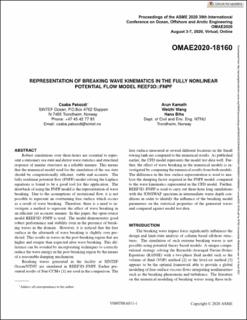| dc.contributor.author | Pakozdi, Csaba | |
| dc.contributor.author | Kamath, Arun | |
| dc.contributor.author | Wang, Weizhi | |
| dc.contributor.author | Bihs, Hans | |
| dc.date.accessioned | 2021-04-14T11:26:56Z | |
| dc.date.available | 2021-04-14T11:26:56Z | |
| dc.date.created | 2020-12-23T09:05:38Z | |
| dc.date.issued | 2020 | |
| dc.identifier.isbn | 978-0-7918-8440-9 | |
| dc.identifier.uri | https://hdl.handle.net/11250/2737726 | |
| dc.description.abstract | Robust simulations over three-hours are essential to represent a stationary sea state and derive wave statistics and structural response of marine structures in a reliable manner. This means that the numerical model used for the simulation of the sea state should be computationally efficient, stable and accurate. The fully nonlinear potential flow (FNPF) model solving the Laplace equations is found to be a good tool for this application. The drawback of using the FNPF model is the representation of wave breaking. Due to the assumptions of irrotational flow, it is not possible to represent an overturning free surface which occurs as a result of wave breaking. Therefore, there is a need to investigate a method to represent the effect of wave breaking in an efficient yet accurate manner. In this paper, the open-source model REEF3D::FNPF is used. The model demonstrates good robust performance and stability even in the presence of breaking waves in the domain. However, it is noticed that the free surface in the aftermath of wave breaking is slightly over predicted. This results in waves in the post-breaking region that are higher and steeper than expected after wave breaking. This difference can be avoided by incorporating techniques to correctly reduce the wave energy in the post-breaking region by the means of a reasonable damping mechanism. Breaking waves generated in the facility at SINTEF Ocean/NTNU are simulated in REEF3D::FNPF. Earlier presented results of Star-CCM+ [1] are used in the comparison. The free surface measured at several different locations in the Small towing tank are compared to the numerical results. As published earlier, the CFD model represents the model test data well. Further, the effect of wave breaking in the numerical models is investigated by comparing the numerical results from both models. The difference in the free surface representation is used to analyze the damping factor required in the FNPF model, compared to the wave kinematics represented in the CFD model. Further, REEF3D::FNPF is used to carry out three-hour long simulations with the JONSWAP spectrum in intermediate water depth conditions in order to identify the influence of the breaking model parameters on the statistical properties of the generated waves and compared against model test data. | en_US |
| dc.language.iso | eng | en_US |
| dc.publisher | ASME | en_US |
| dc.relation.ispartof | ASME 2020 39th International Conference on Ocean, Offshore and Arctic Engineering - Volume 8: CFD and FSI | |
| dc.title | Representation of Breaking Wave Kinematics in the Fully Nonlinear Potential Flow Model REEF3D::FNPF | en_US |
| dc.type | Chapter | en_US |
| dc.description.version | publishedVersion | en_US |
| dc.identifier.doi | http://dx.doi.org/10.1115/OMAE2020-18160 | |
| dc.identifier.cristin | 1862989 | |
| dc.description.localcode | Locked until 18.6.2021 due to copyright restrictions. Copyright © 2020 by ASME | en_US |
| cristin.ispublished | true | |
| cristin.fulltext | postprint | |
| cristin.qualitycode | 1 | |
